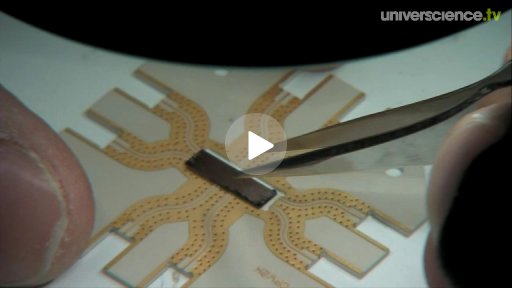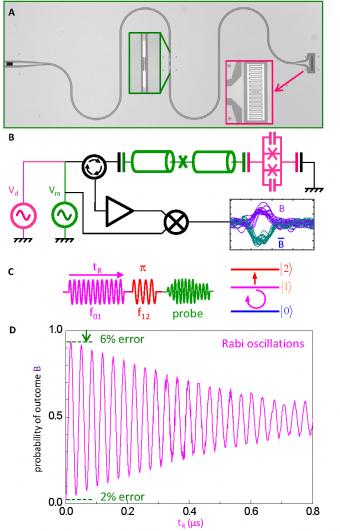accurate “single shot” readout of a superconducting quantum bit

After the realization in 2002 of one of the first solid state quantum bits (qubits), scientists from the Quantronique IRAMIS-SPEC research group have performed a further step towards the realization of an elementary quantum processor: the accurate and non destructive readout of such a qubit.
The qubit is the basic unit of information in quantum computers, future machines that would process efficiently information through the massive parallelism made possible by the laws of quantum mechanics. Such a quantum computer is still a dream for physicists, but advances are rapid in many laboratories around the world. The implementation of a quantum processor requires the development of several components: qubits that retain their quantum coherence for a sufficiently long time, single-qubit and two-qubit logic gates, and a readout device that can measure the state of a qubit with minimal errors in a single step projection while preserving the quantum state obtained after this projection.
The "Quantronics group" has demonstrated such a readout device for a superconducting qubit, the transmon [1,2], a promising version of a component widly known as the "Cooper pair box". This circuit has several discrete energy states (0, 1, 2...), of which the two lowest are used to define the qubit. When it is placed inside a microwave resonator, its quantum state can be read by sending a wave to the system and by measuring the phase of the reflected signal. This process leads, however, to many errors because it is too slow to identify the state 1 before it is destroyed by spontaneous emission.
To solve this issue, the scientists have added a tunnel junction to the resonator in order to make it nonlinear and behave as a "sample and hold" detector [3]; viz, when the microwave pulse is sent, the resonator adopts an oscillatory state that depends on the qubit state (B for 1, B for 0). This resonator state is now conserved as long as the probe signal is maintained even if the qubit state is lost by spontaneous emission, thus allowing an easy next discrimination of the two qubit states. With this single-shot measurement, the qubit state is correctly measured with a probability of 92%. This is high enough to consider the use of such a device in a basic processor with a few qubits. These results, which are among the best in accuracy obtained to date for superconducting qubit readout, are now being published in Nature Physics [4].
Figure: A) Optical micrograph of the device. Magenta frame: transmon in a superconducting resonator (meander) with a Josephson junction (green frame) inserted in the middle . B) Circuit diagram showing the transmon (magenta), the resonator (green) and the junction (green cross), the microwave sources Vd and Vm for controlling and reading the qubit, respectively, and the measurement circuit (black). Ending frame: oscillogram of the signal for the two states (Bbar and B). C) Principle of the experiment: a first microwave pulse resonant with the 0→1 transition of the qubit induces coherent oscillations (so-called Rabi oscillations) between the two states, a second pulse transfers the transmon state 1 to state 2, protecting it against spontaneous emission, and a third pulse then reads the qubit state. D) Rabi oscillations given by the probability of getting the outcome B. The high contrast obtained is limited by the error rate; that is, 2% for the 0 state and 6% for the 1 state.
Quantronics Group,
Service de Physique de l'Etat Condensé (CNRS URA 2464)
DSM/IRAMIS/SPEC, CEA-Saclay, F-91191 Gif-sur-Yvette Cedex, France
References:
[1] J. Koch et al., Phys. Rev. A 76, 042319 (2007).
[2] A. Wallraff et al., Nature 431, 162 (2004).
[3] Dispersive microwave bifurcation of a superconducting resonator cavity incorporating a Josephson junction
E. Boaknin, V. Manucharyan, S. Fissette, M. Metcalfe, L. Frunzio, R. Vijay, I. Siddiqi, A. Wallraff, R. J. Schoelkopf, and M. Devoret, arXiv:cond-mat/0702445v1.
[4] Single-shot qubit readout in circuit quantum electrodynamics
François Mallet, Florian R. Ong, Agustin Palacios-Laloy, François Nguyen, Patrice Bertet, Denis Vion & Daniel Esteve
Nature Physics (2009), published online: 27 September 2009.
CEA press release: "Lecture haute-fidélité pour ordinateur quantique"
 |
Video presented by the "Cité des Sciences et de l'industrie": "Demain, l'ordinateur quantique".
|
•  Future optics and electronics › Quantum physics and nanoelectronics
Future optics and electronics › Quantum physics and nanoelectronics













